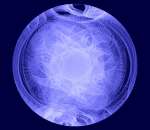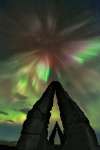
|
Astronomy Picture Of the Day (APOD)
 Fermi Epicyles: The Vela Pulsar s Path
Fermi Epicyles: The Vela Pulsar s Path
4.05.2012
Exploring the cosmos at extreme energies, the Fermi Gamma-ray Space Telescope orbits planet Earth every 95 minutes. By design, it rocks to the north and then to the south on alternate orbits in order to survey the sky with its Large Area Telescope (LAT).
 M106 Close Up
M106 Close Up
3.05.2012
Close to the Great Bear (Ursa Major) and surrounded by the stars of the Hunting Dogs (Canes Venatici), this celestial wonder was discovered in 1781 by the metric French astronomer Pierre Mechain. Later, it was added to the catalog of his friend and colleague Charles Messier as M106.
 Saturns Moon Helene in Color
Saturns Moon Helene in Color
2.05.2012
Although its colors may be subtle, Saturn's moon Helene is an enigma in any light. The moon was imaged in unprecedented detail last June as the robotic Cassini spacecraft orbiting Saturn swooped to within a single Earth diameter of the diminutive moon.
 Higgs Boson Explained by Cartoon
Higgs Boson Explained by Cartoon
1.05.2012
What is all this fuss about the Higgs boson? The physics community is abuzz that a fundamental particle expected by the largely successful Standard Model of particle physics may be soon be found by the huge Large Hadron Collider (LHC) at CERN in Europe.
 Aurora Over RaufarhЖfn
Aurora Over RaufarhЖfn
30.04.2012
It was all lined up even without the colorful aurora exploding overhead. If you follow the apex line of the recently deployed monuments of Arctic Henge in RaufarhЖfn in northern Iceland from this vantage point, you will see that they point due north.
 A Dangerous Sunrise on Gliese 876d
A Dangerous Sunrise on Gliese 876d
29.04.2012
On planet Gliese 876d, sunrises might be dangerous. Although nobody really knows what conditions are like on this close-in planet orbiting variable red dwarf star Gliese 876, the above artistic illustration gives one impression.
 Sutter s Mill Meteorite
Sutter s Mill Meteorite
28.04.2012
Last Sunday's bright fireball meteor falling through skies over California and Nevada produced sonic booms over a broad area around 7:21 am. Estimates indicate the meteor was about the size of a minivan.
 Jupiter and the Moons of Earth
Jupiter and the Moons of Earth
27.04.2012
Planet Earth has many moons. Its largest artifical moon, the International Space Station, streaks through this lovely skyview with clouds in silhouette against the fading light of a sunset. Captured from Stuttgart, Germany last Sunday, the frame also includes Earth's largest natural satellite 1.5 days after its New Moon phase.
 Morning, Moon, and Mercury
Morning, Moon, and Mercury
26.04.2012
Last week Mercury wandered far to the west of the Sun. As the solar system's innermost planet neared its greatest elongation or greatest angle from the Sun (for this apparition about 27 degrees) it was joined by an old crescent Moon.
 Meteor Over Crater Lake
Meteor Over Crater Lake
25.04.2012
Did you see it? One of the more common questions during a meteor shower occurs because the time it takes for a meteor to flash is typically less than the time it takes for a head to turn.
|
January February March April May June July August September October November December |
|||||||||||||||||||||||||||||||||||||||||||||||||